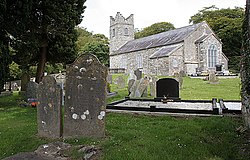Creggan, County Armagh: Difference between revisions
Created page with '{{Infobox town |name=Creggan |county=Armagh |picture= |picture caption= |os grid ref=H9316 |LG district=Newry & Mourne }} '''Creggan''' is a village in County Armagh. {{stu…' |
No edit summary |
||
| Line 2: | Line 2: | ||
|name=Creggan | |name=Creggan | ||
|county=Armagh | |county=Armagh | ||
|picture= | |picture=Creggan Church of Ireland. - geograph.org.uk - 507822.jpg | ||
|picture caption= | |picture caption=Creggan Church of Ireland | ||
|population=246 | |||
|census year=2001 | |||
|os grid ref=H9316 | |os grid ref=H9316 | ||
|latitude=54.084444 | |||
|longitude=-6.575 | |||
|LG district=Newry & Mourne | |LG district=Newry & Mourne | ||
|townland=yes | |||
}} | }} | ||
'''Creggan''' is a village in [[County Armagh]]. | '''Creggan''' is a small village, [[townland]] and parish near [[Crossmaglen]] in [[County Armagh]], [[Northern Ireland]]. In the 2001 Census it had a population of 246 people. The name comes from the Irish ''an Creagán''.<ref>[http://www.logainm.ie/1165904.aspx Placenames Database of Ireland]</ref> | ||
{{ | == Places of interest == | ||
Creggan Church Yard, near Crossmaglen is home to some of Ireland's best known Gaelic poets. The current [[Church of Ireland]] church dates back to 1731 but there is evidence to suggest an earlier Catholic church preceded it. This is the burial place of three 18th century Irish poets: Art MacCooey, Pádraig Mac Aliondain and Séamus Mór MacMurphy. It is also the burial place of the clan O’Neill. The O’Neills of Tyrone invaded South Armagh during the middle of the 15th century. The burial place was re-discovered in 1971 during a cleanup of the cemetery for the proposed bi-centennial celebrations of Art MacCooey. It is reputed the O’Neills arrived in Creggan in 1447 and the burial place currently contains approximately 70 skulls. | |||
On the banks of the River Creggan overlooking the rolling green hills of South Armagh stands Church of Ireland Creggan Church and graveyard. This is now a listed historical building and the grounds are surrounded by an ancient stone wall: her old gravestones stand in stark contrast to the small cluster of modern houses just beyond those walls. | |||
According to local folklore Creggan dates back to the 14th century. A congregation of mourners nearby were lowering their deceased loved one into the ground at Killyloughrain when they heard a distant tolling bell. This was read as a sign from God and they followed to the source of the ringing. It was here they buried their dead and that place, Creggan, became hallowed and the site of their Church. | |||
The present Church is believed to have been built in 1758 with the tower being added in 1799. The building itself might incorporate part of an earlier pre-schism Church. The O’Neill Vault is believed to have been situated under the altar of the latter. | |||
Now the vault lies outside the present Church building. The most famed of recent rectors was the Rev Mervyn Kingston. | |||
== References == | |||
{{reflist}} | |||
*[http://www.ninis.nisra.gov.uk/ NI Neighbourhood Information System] | |||
*[http://www.enjoyireland.com/armagh/ Enjoy Ireland] | |||
*[http://www.culturenorthernireland.org/article.aspx?county=3&articleID=1609&cultID=25&townID=0&cultSubID=0&page=0&navID=5 Culture Northern Ireland] | |||
== Outside links == | |||
*[http://www.cregganhistory.co.uk/index.htm Creggan History Society] | |||
Revision as of 11:16, 11 November 2015
| Creggan | |
| County Armagh | |
|---|---|
 Creggan Church of Ireland | |
| Location | |
| Grid reference: | H9316 |
| Location: | 54°5’4"N, 6°34’30"W |
| Data | |
| Population: | 246 (2001) |
| Local Government | |
| Council: | Newry, Mourne and Down |
Creggan is a small village, townland and parish near Crossmaglen in County Armagh, Northern Ireland. In the 2001 Census it had a population of 246 people. The name comes from the Irish an Creagán.[1]
Places of interest
Creggan Church Yard, near Crossmaglen is home to some of Ireland's best known Gaelic poets. The current Church of Ireland church dates back to 1731 but there is evidence to suggest an earlier Catholic church preceded it. This is the burial place of three 18th century Irish poets: Art MacCooey, Pádraig Mac Aliondain and Séamus Mór MacMurphy. It is also the burial place of the clan O’Neill. The O’Neills of Tyrone invaded South Armagh during the middle of the 15th century. The burial place was re-discovered in 1971 during a cleanup of the cemetery for the proposed bi-centennial celebrations of Art MacCooey. It is reputed the O’Neills arrived in Creggan in 1447 and the burial place currently contains approximately 70 skulls.
On the banks of the River Creggan overlooking the rolling green hills of South Armagh stands Church of Ireland Creggan Church and graveyard. This is now a listed historical building and the grounds are surrounded by an ancient stone wall: her old gravestones stand in stark contrast to the small cluster of modern houses just beyond those walls. According to local folklore Creggan dates back to the 14th century. A congregation of mourners nearby were lowering their deceased loved one into the ground at Killyloughrain when they heard a distant tolling bell. This was read as a sign from God and they followed to the source of the ringing. It was here they buried their dead and that place, Creggan, became hallowed and the site of their Church. The present Church is believed to have been built in 1758 with the tower being added in 1799. The building itself might incorporate part of an earlier pre-schism Church. The O’Neill Vault is believed to have been situated under the altar of the latter. Now the vault lies outside the present Church building. The most famed of recent rectors was the Rev Mervyn Kingston.